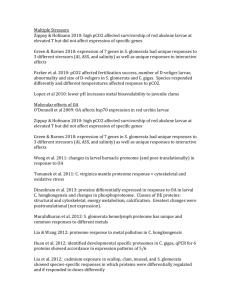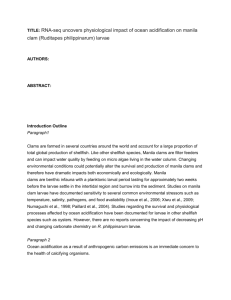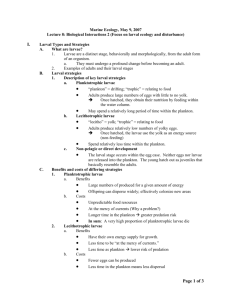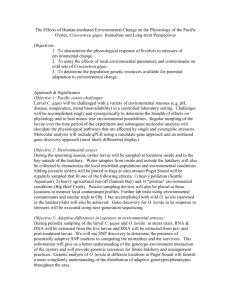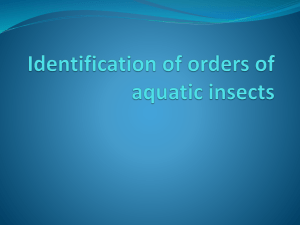dissertation proposal outline 120KB Aug 28 2011
advertisement
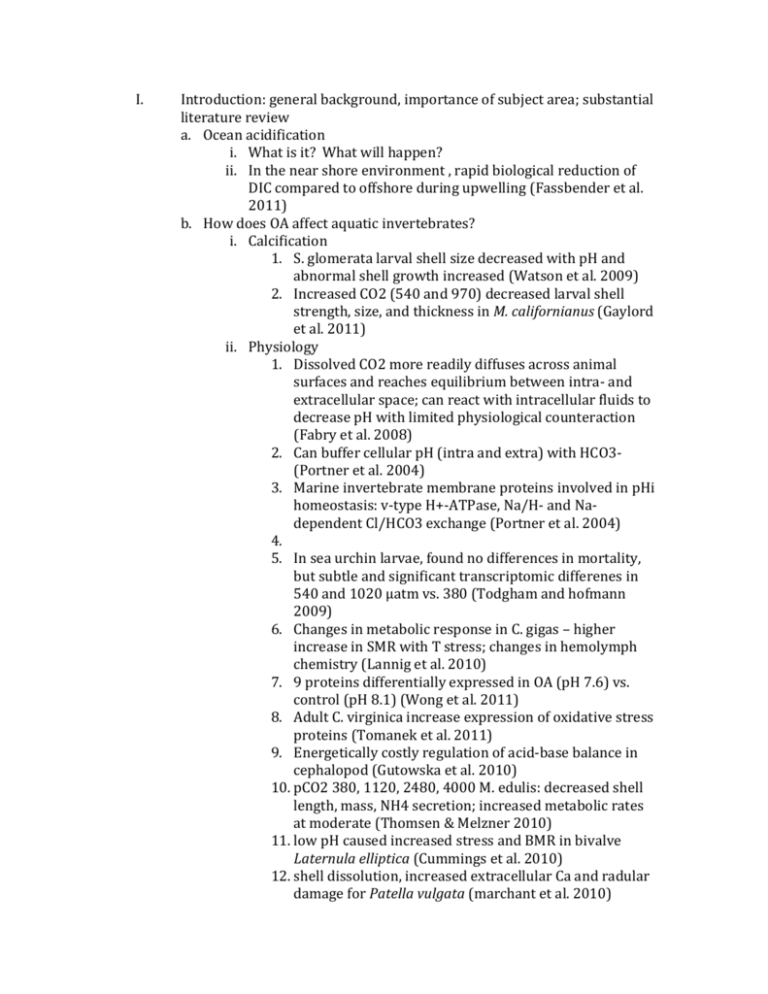
I. Introduction: general background, importance of subject area; substantial literature review a. Ocean acidification i. What is it? What will happen? ii. In the near shore environment , rapid biological reduction of DIC compared to offshore during upwelling (Fassbender et al. 2011) b. How does OA affect aquatic invertebrates? i. Calcification 1. S. glomerata larval shell size decreased with pH and abnormal shell growth increased (Watson et al. 2009) 2. Increased CO2 (540 and 970) decreased larval shell strength, size, and thickness in M. californianus (Gaylord et al. 2011) ii. Physiology 1. Dissolved CO2 more readily diffuses across animal surfaces and reaches equilibrium between intra- and extracellular space; can react with intracellular fluids to decrease pH with limited physiological counteraction (Fabry et al. 2008) 2. Can buffer cellular pH (intra and extra) with HCO3(Portner et al. 2004) 3. Marine invertebrate membrane proteins involved in pHi homeostasis: v-type H+-ATPase, Na/H- and Nadependent Cl/HCO3 exchange (Portner et al. 2004) 4. 5. In sea urchin larvae, found no differences in mortality, but subtle and significant transcriptomic differenes in 540 and 1020 µatm vs. 380 (Todgham and hofmann 2009) 6. Changes in metabolic response in C. gigas – higher increase in SMR with T stress; changes in hemolymph chemistry (Lannig et al. 2010) 7. 9 proteins differentially expressed in OA (pH 7.6) vs. control (pH 8.1) (Wong et al. 2011) 8. Adult C. virginica increase expression of oxidative stress proteins (Tomanek et al. 2011) 9. Energetically costly regulation of acid-base balance in cephalopod (Gutowska et al. 2010) 10. pCO2 380, 1120, 2480, 4000 M. edulis: decreased shell length, mass, NH4 secretion; increased metabolic rates at moderate (Thomsen & Melzner 2010) 11. low pH caused increased stress and BMR in bivalve Laternula elliptica (Cummings et al. 2010) 12. shell dissolution, increased extracellular Ca and radular damage for Patella vulgata (marchant et al. 2010) 13. decreased growth rate in M. edulis, but acclimation in terms of pHi (Michaelidis et al. 2005) 14. Energy required to maintain external vs. internal [H] gradient will increase with CO2 for organisms that remove a fixed number of H from calcification fluid and decrease for organisms that maintain a fixed ratio; temperate coral A. poculata maintains fixed ratio so calcifying fluid [CO3] decreases (Ries 2011) 15. S. purpuratus larvae showed developmental delay under high pCO2 (pH 7.7, 1264 µatm) and routine metabolic rate increased more and scope for growth less – developmental delays are caused by altered energy budgets under environmental stress (Stumpp et al. 2011) 16. S. purpuratus larval genes different at high pCO2: ion transport, calcification, metabolism, cellular stress respose (Stumpp et al. 2011) 17. Shrimp had developmental delay; mussels did not, but were increasingly smaller with time at pH 7.6 (Bechmann et al. 2011) 18. Molecular plasticity of urchin Paracentrotus lividus larvae may aid in combating OA (Martin et al. 2011) iii. In combination with other stressors 1. C. gigas has limited ability to biotransform PCP, most is depurated and some is metabolized (Shofer & Tjeerdema 1993) 2. ETC genes important in response to metals, organic pollutants, and nutrients and ribosomal proteins – 11 creeks with different environmental conditions compared for C. virginica (Chapman et al. 2011) 3. Tidal emersion and PAH exposure in M. edulis resulted in some shared and some unique proteomic responses (Letendre et al. in press) iv. Reproduction and evolutionary implications 1. Wild vs. selectively bred S. glomerata survived less well in 856 vs. 380 µatm; rate of development slower at 856 µatm and in wild oysters and in oysters conditioned at ambient; larvae survived better in broodstock conditioned at high pCO2 (Parker et al. in press) II. c. Objectives: concise statement of purpose or objectives of the project; short and specific a. How does ocean acidification affect larval oyster growth, development, calcification, and physiology? b. How does exposure to acidic conditions affect juvenile oyster response to secondary stressors? III. c. How does conditioning in acidic water affect adult oyster fitness and larval survival? Methods: general plan, specific methods, sampling or experimental design, projected procedure for data analysis; directly address the purposes or objectives; organize by objective/chapter a. Larvae i. Expose larvae to 3 different levels of pCO2 during first week of development ii. Monitor water chemistry iii. Measure: growth, calcification, developmental stage 1. SEM 2. Proportional density 3. Stats normalized for number of larvae 4. Does developmental delay appear in changes in density? iv. End-point samples for gene expression – candidate genes 1. Shell mineralization: 8 proteins from marie et al. 2011; Kurihara et al. 2007 2. Oxidative stress: peroxiredoxin, superoxide dismutase (Tomanek et al. 2011) 3. Energy metabolism – ATP synthase, citrate synthase, pyruvate kinase, thiolase (Stumpp et al. 2011; Wong et al. 2011) 4. Molecular chaperones (Wong et al. 2011) v. b. Juveniles (2nd stressor) i. Precondition oysters to one of 3 pCO2 (400, 700, 1000) for 1 or 2 weeks ii. Expose to a second stressor (PCP) for 1 week at 2 different environmentally relevant levels (0.05 and 0.15 ng/µL) iii. Find 1 hour lethal temperature (50% dead after one hour) = heat shock 1. Expose to sublethal temp for one hour then lethal for range of times (1 hour and more); controls would not be exposed to sublethal 2. Clegg et al. 1998; Hamdoun; Lang and Camara iv. Gene expression and gill histology 1. See above 2. Acid-base balance; ETC; detoxification v. Whole proteome sequencing (Bob Morris UW Oceanography) vi. Methylation c. Adults (fitness) i. Condition adults (selectively bred and wild) for 2 months at lower and upper water intake in Dabob Bay ii. Quantify gonadal development 1. Histology for gametogenesis (Li et al. 2000) IV. V. VI. 2. Send out biochemical analysis? iii. Spawn and assess larval development and survival and familyspecific survival 1. Genotype adults and larvae to determine genotypedependent survival – what is the distribution of genotypes for the different broodstocks and the different conditions? 2. Maternal effects – females exposed to OA with males not and vice versa Interpretation: How will the results be interpreted in the context of the research questions identified in the purpose and objectives section? Explicitly stated inferences that would be drawn from all outcomes Significance: Justification of investigation; scientific or practical contribution; results will be a significant contribution to knowledge, regardless of the experimental or observational outcomes Timeline/Workplan: feasibility, establish milestones
